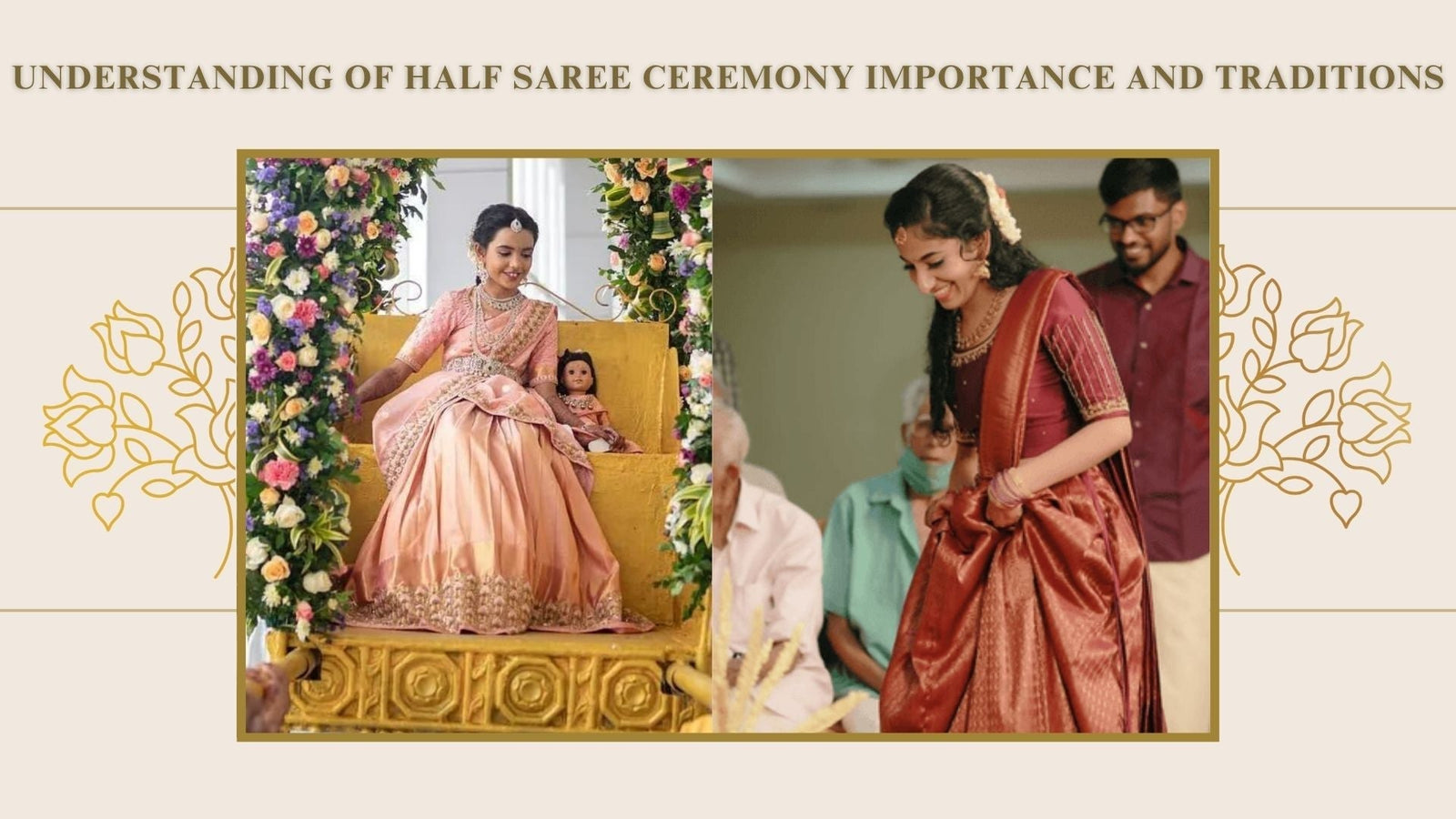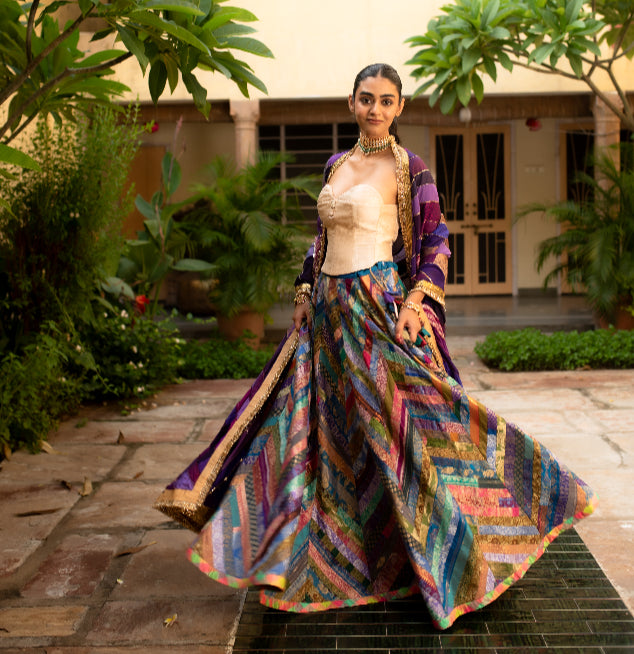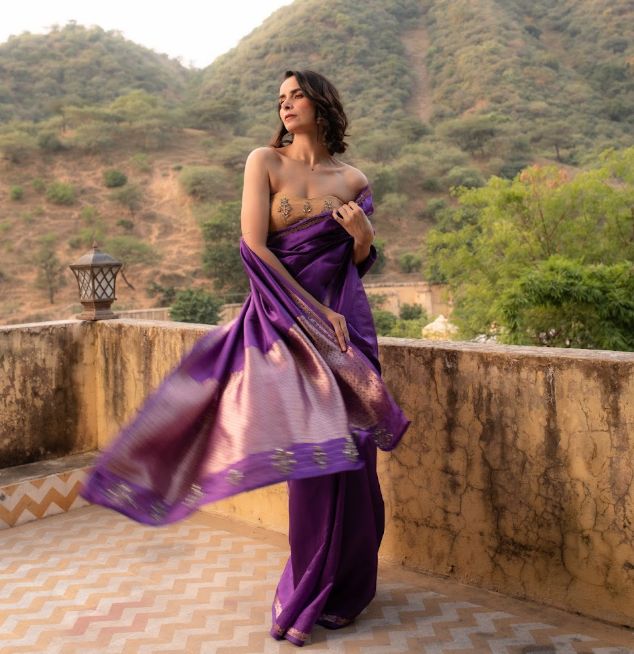Understanding of Half Saree Ceremony Importance and Traditions

Introduction
In South India, the ‘Half Saree Ceremony,’ or Ritu Kala Samskara/Langa Voni function, is a unique affair. It's the celebration of a naive girl turning into a woman. Change is the only constant; a few things are still to be changed, and that is the way to enjoy our culture, womanhood, and family ties and their traditions. Just like the intricate embroidery of a Priyanka Raajiv masterpiece, the ceremony is a complex fusion of generational and feminine values with cultural pride. The function isn't merely a life step; it expresses who we are (culturally) and what we stand for, and is a matter of immense joy for concerned families.
What is the Half Saree Ceremony?

Commonly practised in the South of India, the ‘Half Saree Ceremony’ happens on the commencement of menstruation for the girl. The function is received neither in embarrassment nor shame but as a welcome—with pomp and show—celebrating her initiation into a new life phase. In the ceremony, the girl first wears a lehenga or pavadai (an ankle-length skirt that is typically worn on traditional festivals and passage rite occasions) with a fitting blouse made of pure silk or cotton fabric and then subsequently a half saree (dupatta, skirt, and blouse) gifted or presented by her mama (mother's brother) or other close relatives as a symbol of her entering adolescence.
How is the Half Saree Ceremony Celebrated?

Although the custom was unique to every community and region, the overall framework of the function remained the same. The girl is first dressed in a typical pavadai (skirt) and blouse combination outfit, often in an uplifting bright colour. The girl is then ceremoniously converted into a half saree (her 'first adult garment'). The girl being blessed and honoured by the elders is the main event in both these ceremonies, and a celebratory feast with relatives and guests is enjoyed. Sometimes, families likewise celebrate the coming-of-age with dance, music, and culture, and the function becomes as much a celebration as a wedding.
If you don't get any idea on what you should do, then check out some of the best trending half saree function ideas and suggestions that will help to choose everything in the right way.
Origin and Cultural Significance of the Half Saree Function

Its roots belong to the ancient Hindu custom, as the Ritu Kala, or first menstruation, was an important rite of passage. In the Vedic period (In Indian history, also known as the Vedic age, roughly spanning from 1500 BCE to 600 BCE), we possessed several rites of passage for stages of life (samskaras), and this rite was one among the others of the broader category of Shodasha Samskaras. It was considered a blessing that a girl reached her puberty, and she was to be worshipped and protected, and hence the rite was instituted not only as a domestic affair but also as a community celebration of fertility, growth, and good fortune.
Importance of Half Saree Ceremony in South Indian Culture

Culturally significant in the Indian states of Tamil Nadu, Andhra Pradesh, Telangana, and Karnataka, the function is not deemed a ritual but an emotional, spiritual, and social point of reference for families. The offering of the half saree from the mama of the girl (maternal uncle) is an indicator of emotional support, and the coming together of the community is an indication of the joint celebration and acceptance. More than a symbolic gesture, the time prompts free discussion about menstruation so that it becomes accepted and revered in our cultural contexts.
Popular Rituals Followed During the Half Saree Function

Heavily rooted in the ancient custom, the Half Saree Ceremony entails the rituals that celebrate the girl's coming of age. The practices observed on the occasion all possess cultural and emotional content and have been passed down through the centuries in devotion. Although practices vary slightly between families and states, some perennial customs remain the core of the much-revered function:
Some common rituals involve:
- The purification ceremony ends with the girl being given a bath with oil.
- On the last day of the ceremonies, the girl is dressed like a bride and temple jewellery as well as floral maduve-malas is adorning her.
- Lighting of the Lamp: The lighting of a very sacred fire to celebrate the occasion would mean honour.
- Elder's Blessings: Her family elders bestow upon her gifts and jewellery, apart from life lessons.
- Community Meal (Sadhya or Feast): As a conclusion to the installation rites, it is presented with a grand vegetarian feast served on banana leaves as a token of abundance and sanctity.
- Such rituals attain deep significances - blessings of fertility, gifts for the female, and prayers for a brilliant future.
Gift Ideas for Half Saree Ceremony

Gifts feature prominently in this activity. Not only will the thoughtful gifts make the activity memorable, but they will also help ease the passing of the girls gracefully and practically.
Some of the most popular gifts used are:
- Conventional Jewelleries: Gold belt on the abdomen (vaddanam), earrings or a bangle or two.
- Half Saree Set/Pattu Pavadai: Certain silk clothing from handloom-friendly brands may be opted for.
- Indian culture/mythology books: These forge a tighter relation with one’s roots.
-
Personalised tokens: Memory boxes or personalised letters from grandparents are typically preferred over the most expensive gifts.
Gifting with Priyanka Raajiv is our pursuit to give your loved ones a luxury piece of the timeless Indian legacy and craftsmanship.

Conclusion
‘Half Saree Ceremony’ is more than a coming-of-age function; it’s a cultural custom. Even with its popular versions springing up all over—photographic opportunities and stylish garments—its gist remains the same. It’s the recognition of womanhood, of custom and familial dignity. The more accustomed you get to its importance, the more the rituals handed down from the foreparents are a joy. And just as Priyanka Raajiv celebrates artisanal beauty and feminine grace, so too does this ceremony pay homage to timeless Indian womanhood—elegant, evolving, and enduring.
FAQs
Q1: At what age is the half saree ceremony performed?
Ans. Most girls got their first menstrual bleeding between 11 to 14 years of age, and it was the indicator for the initiation ceremony.
Q2: What is the dress code for the Half Saree Ceremony?
Ans. Generally, a girl who gets the honour wears a pavadai-davani or half saree. The women who are with her may take bright coloured sarees, lehengas, or kurtas.
Q3: What is the difference between a Half Saree and a Saree?
Ans. While a half saree is made up of a skirt (lehenga) and blouse, along with a dupatta draped over one shoulder, a saree, considered a full saree, is a piece of cloth, usually around six yards long, which is draped in a specific style around the body.
Q4: Is the half saree ceremony only for South Indian girls?
Ans. While originally based on South Indian tradition, the ceremony has motivated parallel ceremonies in other regions of India by different names and formats.
Q5: Can a half saree ceremony be done in modern themes?
Ans. Yes, a lot of families these days also have the ceremony with modern decor and fusion outfits and even choreographed dances while maintaining their traditional spirit.
Q6: What should guests wear to a half saree function?
Ans. Guests are to wear traditional Indian attire. Bright, celebratory colours, but demureness and cultural respect are essential.

